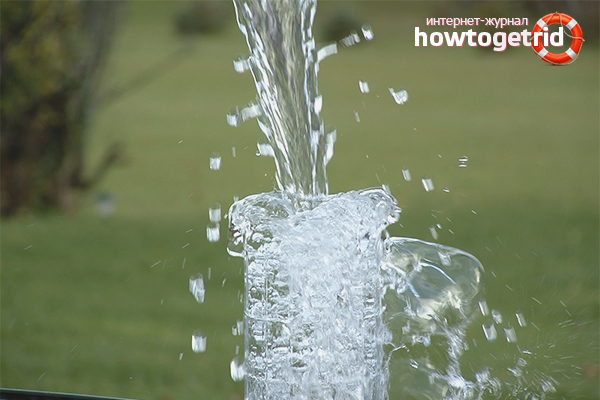The content of the article
Impurities of iron fall into the water from underground deep and surface sources. Mineral is the cause of the red tint, bitter taste and rusty coating on the pipes and walls of household appliances. The additive leads to a breakdown of equipment, causes allergic reactions and dermatological diseases in humans. Aerators, chemicals and special bacteria can reduce the iron concentration in the water from the well.
Homemade design
In the underground sources supplying the well, a lot of divalent mineral. Convert the additive into ferric iron, which settles to the bottom, can ordinary oxygen. Conducting a chemical experiment at home is easy. You will need a large plastic tank with a volume of 800-1000 ml. A tank or barrel is suitable. Need rubber hoses, spray nozzle and faucet. It is not necessary to buy a compressor for an aquarium, but this device will accelerate the conversion of ferrous iron to ferric.
Installation of a treatment plant consists of several steps:
- The attic is freed from excess rubbish, preparing a platform for the tank.
- A tank with a convex bottom is installed on a wooden or brick base, carefully fixed.
- On both sides make holes for rubber pipes. The first is for a hose that moves away from a pump located in the well. The second hole is drilled at a height of 30-40 cm from the bottom. A rubber pipe is connected to it, which will supply the house with clean water.
- A crane is mounted in the lower part of the tank. It is necessary to periodically drain the precipitate.
- A nozzle with small holes is attached to the tube that extends from the well. It is located inside a plastic container.
- The hose that supplies the house with clean water is equipped with a filter for rough cleaning. The element will retain particles of iron that have not settled to the bottom.
A homemade cleaning system works simply. In the evening, the plastic tank is filled with water and include a compressor, which is attached to the outer wall of the tank. The device saturates the liquid with oxygen, which interacts with iron molecules. Particles of the additive become heavy and precipitate. The concentration of harmful impurities decreases 5–7 times.
The process lasts from 12 to 24 hours, depending on the amount of water in the tank. Pure liquid is drained through a second hose. They drink water, use it for watering plants and washing. When the tank is empty, you need to open the faucet, substituting a bucket under it, and drain the brownish liquid with the remnants of iron.
Oxygen against harmful impurities
Tanks for water upholding are used by summer residents who do not need to water the garden every day, cook food, bathe in the shower and wash clothes. Such a volume of water is not enough for large families, so they install expensive reverse osmosis or ozonation systems.
The first type of construction consists of several filters that trap particles of sand, clay and organic impurities. Then the liquid passes through a thin membrane with small cells. They let oxygen and hydrogen molecules pass through, trapping particles of iron and other harmful impurities. The purified water accumulates in a special tank, and then enters the taps.
The ozonation system consists of tanks, tubes, a filter and a generator. Dirty water enters the tank. The generator draws in air and processes it to produce pure ozone. The component enters the fluid reservoirs.A chemical reaction is triggered, due to which the two-component iron turns into a three-component. A precipitate forms which remains at the bottom of the tank. Purified water is passed through a special filter that traps residues of harmful impurities. In the fluid that has passed ozonation, there is no iron, hydrogen sulfide and germs.
The design for ozonation can not be done independently. The generator and water storage tanks are installed by specialists.
At home, you can clean small portions of liquid for drinking and cooking:
- You will need a household ozonizer, which resembles a computer mouse in size.
- Water is poured into a glass container. Do not use metal or ceramic dishes.
- A thin plastic tube of the device is immersed in a liquid, and the ozonizer itself is placed on the table.
- Turn on the device for 10-15 minutes. Ozone will trigger chemical reactions that will gradually turn bicomponent iron molecules into ternary ones.
- Water is insisted for 5-6 hours. Enough time for iron to precipitate.
- The top layer of liquid is carefully poured into a clean container. The remains are poured into the sewer or onto the street.
In a similar way, water is purified for cooking and domestic needs. The maximum volume of liquid that the ozonizer can process in one session is 100-150 liters.
Bacteria and Chlorination
Molecules of ferrous iron enter into chemical reactions not only with oxygen, but also with chlorine. The substance purifies water from minerals and bacteria. A weak chlorine solution can be poured into the well or a capsule with a chemical additive can be lowered. The second method is more convenient, because the cartridge independently calculates the dosage of the disinfectant.
Chlorinated water must be passed through a charcoal filter or a thin membrane with small cells. The additive triggers chemical reactions, and most of the iron settles to the bottom of the well, but some particles remain. Filters trap the remaining molecules of harmful metals. Instead of chlorine, potassium permanganate and calcium hypochlorite are used.
Oxidative reactions trigger special bacteria. They interact with iron and hydrogen sulfide. Metals turn into sediment and remain at the bottom of the well. After oxidation, bacteria-filled water is passed through microfilters and treated with ultraviolet rays to disinfect.
The biological method is long and expensive, so it is rarely used at home.
Magnetic field and resin filters
Divalent metals are removed from the water by ion exchange. Filters similar to cylindrical capsules contain membranes with cation exchangers. Synthetic ion-exchange resins even retain ferrous iron molecules, so water does not go through the aeration and oxidation stages.
But the membranes quickly clog, you have to constantly buy new ones. The method is quite costly and not the most effective.
Water that enters the water supply from the well is passed through magnetic filters. They destroy hard salts, make them soft and loose. Iron particles do not stick to pipes, walls of household appliances, but simply go outside with water and settle to the bottom of the tank.
Devices emitting a magnetic field are fixed to the pipes using flanges or a fitting connection. Filters work for 1.5–2 years, then lose their properties.
You can create a device for cleaning water from iron at home. You will need an old radio or other unnecessary equipment, inside of which there are magnets. The number of filter blanks depends on their capacity. Sometimes 5 pieces are enough, but it is better to take 10 or 15.
Magnets are fastened together by a wire. The blanks are tightly wound to each other so that they do not slip or fall out during operation. Parts of the filter should be equally spaced.
You can make a case for a cleaning installation from a plastic bottle.Cut the neck and bottom, put the workpiece on the pipe. Magnets connected by a wire catch on top. A homemade filter lasts 2-3 years. It is better to defend the water that has passed through the home treatment plant before drinking and cooking.
No settling
The budget option for filtering is a plastic barrel, into which water is poured and wait until harmful impurities precipitate. Usually the process lasts 24 hours. But if a large family lives in the house who constantly needs clean liquid for drinking and washing, a day is too much.
There is a way out of the situation. You need to create a design that purifies water in a matter of hours. It consists of a plastic barrel or tank with a volume of 200-300 liters. The capacity does not have to be lifted to the attic; it can be installed in any heated room.
A rubber hose is connected to the barrel on one side, which connects the reservoir to the well. It is installed at a height of 70–90 cm from the bottom. On the opposite side make a hole for the pipe, which is attached to the pumping station. The appliance supplies water to the house. A plastic pipe is attached to the pump. Inside it there are two filters: coal and mechanical. They recommend trying an inexpensive option like Poseidon. You will also need an automatic system that will monitor the water level in the barrel.
A shower head is attached to the pipe that connects the reservoir to the well. Water enters the barrel and dissipates, enriched with oxygen. Ozone triggers chemical reactions, and iron particles are oxidized. Trivalent molecules are heavy, so part settles to the bottom.
A liquid saturated with oxygen passes through a carbon filter that absorbs metal particles. The second, mechanical, membrane retains iron residues. Then clean and disinfected water gets into the house.
The mechanical filter is changed every two weeks, and the coal species is thrown away every month. Every six months you need to clean the barrel of plaque.
If you install an aquarium aerator in the tank, which enriches the water with a large amount of oxygen, the quality of the drinking liquid will improve 2-3 times.
Such a filter unit removes unpleasant odors and protects household appliances from scale. Helps with high concentrations of manganese, iron and hydrogen sulfide.
Additional methods
Water quality will improve the catalytic method. The fluid enters the tank filled with bulk filters. They consist of porous materials that absorb molecules of iron and other metals well. Water goes through an oxidation step, then settles in the tank. Harmful minerals precipitate, and pure liquid enters taps.
As filling filters use:
- zeolite;
- dolomite;
- glauconite.
You can buy ready-made compositions for catalytic filters. For example, Magnofilt, Damfer or MZHF. The popular porous substance is Birm. Catalytic fillers do not mix well with substances containing chlorine. When interacting with such additives, they lose their absorbent properties and cease to fulfill the main function.
There are many ways to purify water from a well from iron. You can buy reverse osmosis systems or ozonizers, magnetic or resin filters. Build a budget design with your own hands. Add chlorine or potassium permanganate solution to water. Each owner of the well chooses the method that seems to him the most profitable and effective.
Video: how to clean a well, column or well










Submit